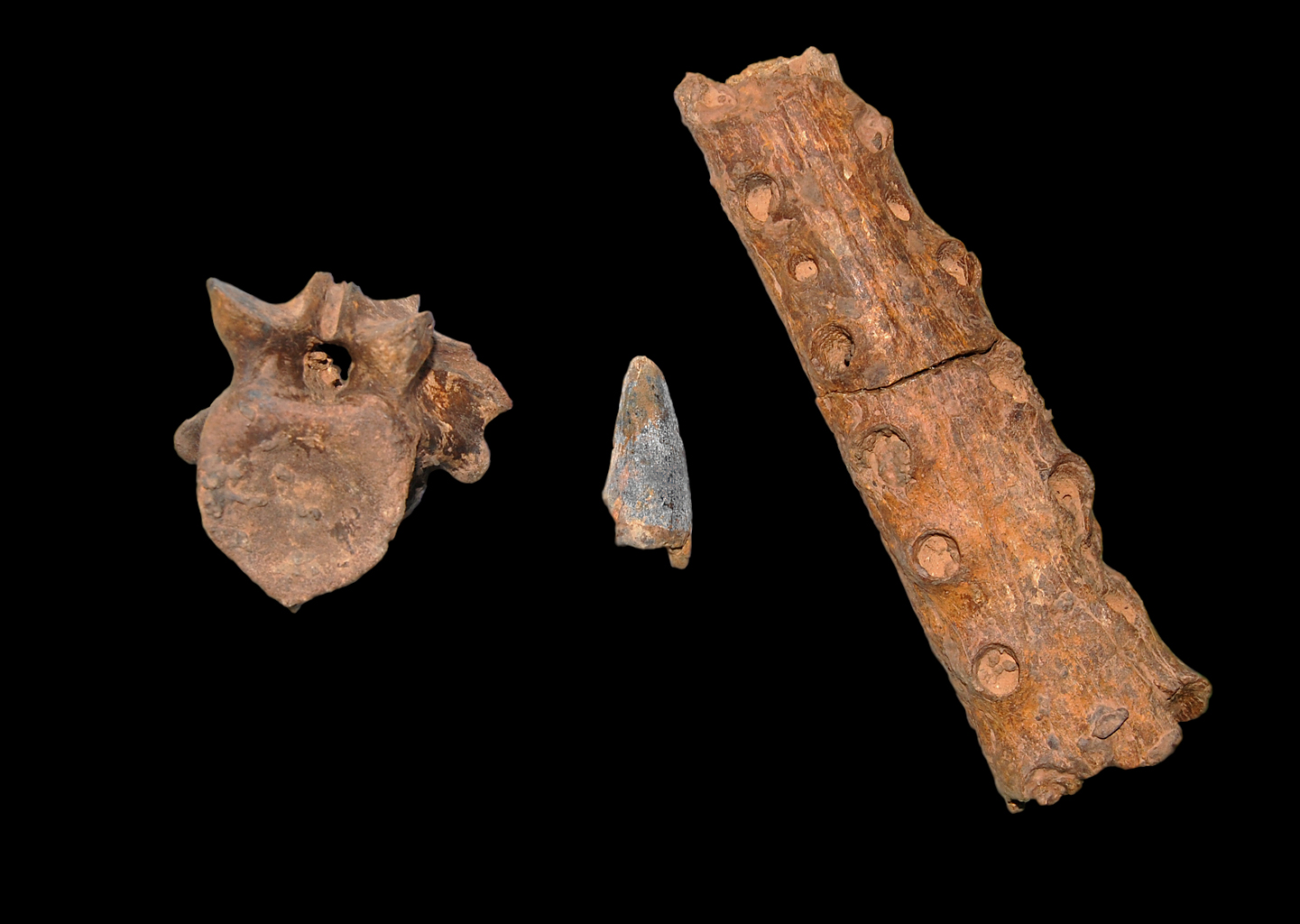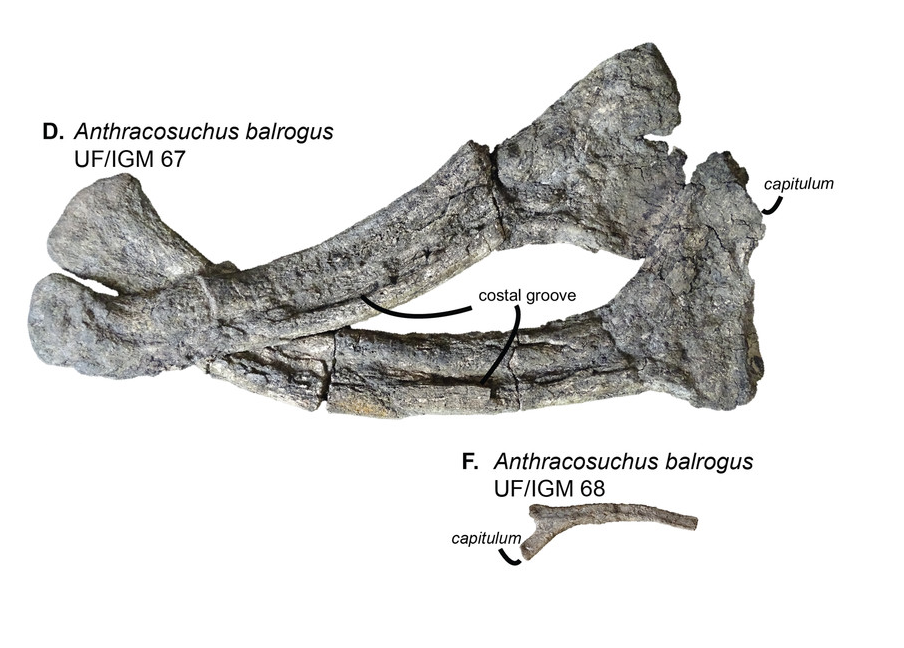|
Dyrosaurid
Dyrosauridae is a family of extinct neosuchian crocodyliforms that lived from the Late Cretaceous (Maastrichtian) to the Eocene. Dyrosaurid fossils are globally distributed, having been found in Africa, Asia, Europe, North America and South America. Over a dozen species are currently known, varying greatly in overall size and cranial shape. A majority were aquatic, some terrestrial and others fully marine (see locomotion below), with species inhabiting both freshwater and marine environments. Ocean-dwelling dyrosaurids were among the few marine reptiles to survive the Cretaceous–Paleogene extinction event. The dyrosaurids were a group of mostly marine, long jawed, crocodile-like quadrupeds up to long. The largest dyrosaurid was probably ''Phosphatosaurus'' estimated at in length. Based on bone tissue evidence, it has been hypothesized that they were slow-growing near-shore marine animals with interlocking closed jaws, able to swim as well as walk on land. External nostrils at ... [...More Info...] [...Related Items...] OR: [Wikipedia] [Google] [Baidu] |
Hyposaurus
''Hyposaurus'' is a genus of extinct marine dyrosaurid crocodyliform. Fossils have been found in Paleocene aged rocks of the Iullemmeden Basin in West Africa, Campanian–Maastrichtian (Late Cretaceous) Shendi Formation of Sudan and Maastrichtian (Late Cretaceous) through Danian (Early Paleocene) strata in New Jersey, Alabama and South Carolina. Isolated teeth comparable to ''Hyposaurus'' have also been found in Thanetian (Late Paleocene) strata of Virginia.Denton Jr., R. K., Dobie, J. L. and D. C. Parris, 1997. The Marine Crocodilian ''Hyposaurus'' in North America. from Ancient Marine Reptiles, editors J. M. Callaway and E. L. Nicholls, Academic Press. It was related to ''Dyrosaurus''. The priority of the species ''H. rogersii'' has been debated,Norell, M. A. and G. W. Storrs. 1989. Catalogue and review of the type fossil crocodilians in the Yale Peabody Museum. Postilla 203:1-28 however there is no sound basis for the recognition of more than one species from North America. The ... [...More Info...] [...Related Items...] OR: [Wikipedia] [Google] [Baidu] |
Phosphatosaurus
''Phosphatosaurus'' is an extinct genus of dyrosaurid crocodylomorph. It existed during the early Eocene, with fossils having been found from North Africa in Tunisia and Mali. Named in 1955, ''Phosphatosaurus'' is a monotypic genus; the type species is ''P. gavialoides''. A specimen has been discovered from Niger, but it cannot be classified at the species level. ''Phosphatosaurus'' is closely related to the Cretaceous genus ''Sokotosuchus'', which is known from Niger and Mali. Because ''Phosphatosaurus'' is only known from Paleogene localities, the close relationship with ''Sokotosuchus'' implies that there is a long ghost lineage extending back into the Maastrichtian that is not known in the fossil record. Description ''Phosphatosaurus'' is a large dyrosaurid estimated at in length, with blunt teeth. The tip of the snout is spoon-shaped from a lateral expansion of the rostral portion of the mandible. The dentition is nonhomodont. Alveolar "couplets" are present in the lower ... [...More Info...] [...Related Items...] OR: [Wikipedia] [Google] [Baidu] |
Dyrosaurus BW
''Dyrosaurus'' is a genus of extinct crocodylomorph that lived during the early Eocene. The name ''Dyrosaurus'' comes from () the Greek for lizard or reptile, and Dyr for Djebel Dyr (mountain) close to where the type species was discovered. It was a large reptile with an estimated body length of . Species Although the family Dyrosauridae is quite diverse and contains a variety of species, the genus ''Dyrosaurus'' has only two described species: ''D. phosphaticus'' and ''D. maghribensis''. ''D. phosphaticus'' was first discovered in Algeria and Tunisia whereas ''D. maghribensis'' has only been found in Morocco. ''D. maghribensis'' differs from ''D. phosphaticus'' by several synapomorphies, most notably: a smooth dorsal margin of the parietal and widely opened choanae, interfenestral bar wide and strongly T-shaped instead of moderately T-shaped. In ''D. maghribensis'' the lateral and medial dorsal osteoderms are not sutured and have no serrated margin. The anterolateral margin ... [...More Info...] [...Related Items...] OR: [Wikipedia] [Google] [Baidu] |
Dyrosaurus
''Dyrosaurus'' is a genus of extinct crocodylomorph that lived during the early Eocene. The name ''Dyrosaurus'' comes from () the Greek for lizard or reptile, and Dyr for Djebel Dyr (mountain) close to where the type species was discovered. It was a large reptile with an estimated body length of . Species Although the family Dyrosauridae is quite diverse and contains a variety of species, the genus ''Dyrosaurus'' has only two described species: ''D. phosphaticus'' and ''D. maghribensis''. ''D. phosphaticus'' was first discovered in Algeria and Tunisia whereas ''D. maghribensis'' has only been found in Morocco. ''D. maghribensis'' differs from ''D. phosphaticus'' by several synapomorphies, most notably: a smooth dorsal margin of the parietal and widely opened choanae, interfenestral bar wide and strongly T-shaped instead of moderately T-shaped. In ''D. maghribensis'' the lateral and medial dorsal osteoderms are not sutured and have no serrated margin. The anterolateral margin ... [...More Info...] [...Related Items...] OR: [Wikipedia] [Google] [Baidu] |
Cerrejonisuchus
''Cerrejonisuchus'' is an extinct genus of dyrosaurid crocodylomorph. It is known from a complete skull and mandible from the Cerrejón Formation in northeastern Colombia, which is Paleocene in age. Specimens belonging to ''Cerrejonisuchus'' and to several other dyrosaurids have been found from the Cerrejón open-pit coal mine in La Guajira. The length of the rostrum is only 54-59% of the total length of the skull, making the snout of ''Cerrejonisuchus'' the shortest of all dyrosaurids. Description At an estimated length of to , ''Cerrejonisuchus'' was small for a dyrosaur. This size estimate is based on the dorsal skull lengths of specimens UF/IGM 29 and UF/IGM 31. ''Cerrejonisuchus'' has the shortest body length of any known dyrosaur, much smaller than that of the longest dyrosaur, ''Phosphatosaurus gavialoides'', which was to in length. Currently the only known specimens of ''Cerrejonisuchus'' are UF/IGM 29 (the type specimen), UF/IGM 30, UF/IGM 31, and UF/IGM 32. Of the ... [...More Info...] [...Related Items...] OR: [Wikipedia] [Google] [Baidu] |
Arambourgisuchus
''Arambourgisuchus'' ("Prof. Camille Arambourg's crocodile") is an extinct genus of dyrosaurid crocodylomorph from the late Palaeocene of Morocco, found in the region of Sidi Chenane in 2000, following collaboration by French and Moroccan institutions, and described in 2005 by a team led by palaeontologist Stéphane Jouve. ''Arambourgisuchus'' was a large animal with an elongated skull 1 meter in length. History and naming The fossils of ''Arambourgisuchus'' were unearthed in the Spring of 2000 thanks to the collaboration of French (French National Centre for Scientific Research, National Museum of Natural History, France) and Moroccon (Office Chérifien des Phosphates, Ministére de l’Energie et des Mines, Morocco) researchers in the phosphatic deposits of the Ouled Abdoun Basin, Morocco. The deposits of the basin range from the latest Cretaceous (Maastrichtian) to the middle Eocene (Lutetian), with the deposits yielding ''Arambourgisuchus'' dating to the Thanetian age of ... [...More Info...] [...Related Items...] OR: [Wikipedia] [Google] [Baidu] |
Congosaurus
''Congosaurus'' is an extinct genus of dyrosaurid mesoeucrocodylian. Fossils have been found from Lândana, in Angola and date back to the Paleocene epoch. In 1952 and 1964 ''Congosaurus'' was proposed to be synonymous with ''Dyrosaurus''. The genus was later thought synonymous with ''Hyposaurus'' in 1976 and 1980. It has since been proven a distinct genus of dyrosaurid separate from both ''Dyrosaurus'' and ''Hyposaurus''. In 2007, a new species of ''Congosaurus'' was constructed after previously being assigned to '' Rhabdognathus'', and named ''C. compressus'', extending the geographic range of the genus into the present-day Sahara , photo = Sahara real color.jpg , photo_caption = The Sahara taken by Apollo 17 astronauts, 1972 , map = , map_image = , location = , country = , country1 = , .... Lateromedially compressed teeth show its close relation to ''C. bequaerti''. References Pal ... [...More Info...] [...Related Items...] OR: [Wikipedia] [Google] [Baidu] |
Arambourgisuchus Khouribgaensis
''Arambourgisuchus'' ("Prof. Camille Arambourg's crocodile") is an extinct genus of dyrosaurid crocodylomorph from the late Palaeocene of Morocco, found in the region of Sidi Chenane in 2000, following collaboration by French and Moroccan institutions, and described in 2005 by a team led by palaeontologist Stéphane Jouve. ''Arambourgisuchus'' was a large animal with an elongated skull 1 meter in length. History and naming The fossils of ''Arambourgisuchus'' were unearthed in the Spring of 2000 thanks to the collaboration of French (French National Centre for Scientific Research, National Museum of Natural History, France) and Moroccon (Office Chérifien des Phosphates, Ministére de l’Energie et des Mines, Morocco) researchers in the phosphatic deposits of the Ouled Abdoun Basin, Morocco. The deposits of the basin range from the latest Cretaceous (Maastrichtian) to the middle Eocene (Lutetian), with the deposits yielding ''Arambourgisuchus'' dating to the Thanetian age of ... [...More Info...] [...Related Items...] OR: [Wikipedia] [Google] [Baidu] |
Chenanisuchus
''Chenanisuchus'' ("Chenane crocodile") is a genus of dyrosaurid crocodyliform from the Late Cretaceous of Mali and the Late Palaeocene of Sidi Chenane in Morocco. It was described in 2005, after expeditions uncovered it in 2000. The type species is ''C. lateroculi'' ("lateralis", lateral; "oculi", eyes), in reference to the laterally facing eyes. Currently, ''Chenanisuchus'' is the most basal known dyrosaurid. Material Two specimens of ''C. lateroculi'' – OCP DEK-GE 262 (holotype, nearly complete skull with mandibular fragments) and OCP DEK-GE 61 (nearly complete skull) – come from the Sidi Chenane area in Morocco, which is Late Palaeocene (Thanetian) in age.Jouve ''et al.'', 2005. Fossils of ''Chenanisuchus'' were also found in Maastrichtian age strata in Mali, showing that ''Chenanisuchus'' survived the Cretaceous–Paleogene extinction event. Systematics ''Chenanisuchus lateroculi'' is referred to Dyrosauridae by Jouve ''et al.'' (2005), based on three morphologic ... [...More Info...] [...Related Items...] OR: [Wikipedia] [Google] [Baidu] |
Rhabdognathus
''Rhabdognathus'' is an extinct genus of dyrosaurid crocodylomorph. It is known from rocks dating to the Paleocene epoch from western Africa, and specimens dating back to the Maastrichtian era were identified in 2008. It was named by Swinton in 1930 for a lower jaw fragment from Nigeria. The type species is ''Rhabdognathus rarus''. Stéphane Jouve subsequently assessed ''R. rarus'' as indeterminate at the species level, but not at the genus level, and thus dubious. Two skulls which were assigned to the genus ''Rhabdognathus'' but which could not be shown to be identical to ''R. rarus'' were given new species: ''R. aslerensis'' and ''R. keiniensis'', both from Mali. The genus formerly contained the species ''Rhabdognathus compressus'', which was reassigned to ''Congosaurus compressus'' after analysis of the lower jaw of a specimen found that it was more similar to that of the species ''Congosaurus bequaerti''. ''Rhabdognathus'' is believed to be the closest relative to the extinct ... [...More Info...] [...Related Items...] OR: [Wikipedia] [Google] [Baidu] |
Sokotosuchus
''Sokotosuchus'' is an extinct genus of dyrosaurid crocodyliform which existed during the Maastrichtian in western Africa. Fossils of the genus were found in the Dukamaje Formation of Nigeria, and some cranial material has possibly been found in Mali Mali (; ), officially the Republic of Mali,, , ff, 𞤈𞤫𞤲𞥆𞤣𞤢𞥄𞤲𞤣𞤭 𞤃𞤢𞥄𞤤𞤭, Renndaandi Maali, italics=no, ar, جمهورية مالي, Jumhūriyyāt Mālī is a landlocked country in West Africa. Mali .... References Bibliography * Further reading * L. B. Halstead. 1975. ''Sokotosuchus ianwilsoni'' n. g., g. sp., a new teleosaur crocodile from the Upper Cretaceous of Nigeria. Journal of Mining and Geology 11(1-2):101-103 Dyrosaurids Prehistoric pseudosuchian genera Prehistoric marine crocodylomorphs Maastrichtian genera Late Cretaceous crocodylomorphs of Africa Cretaceous Nigeria Fossils of Nigeria Fossil taxa described in 1975 {{paleo-archosaur-stub Fossils of ... [...More Info...] [...Related Items...] OR: [Wikipedia] [Google] [Baidu] |
Anthracosuchus
''Anthracosuchus'' (meaning "coal crocodile" in Greek) is an extinct genus of dyrosaurid crocodyliform from the Paleocene of Colombia. Remains of ''Anthracosuchus balrogus'', the only known species, come from the Cerrejón Formation in the Cerrejón mine,''Anthracosuchus balrogus'' at .org and include four fossil specimens with partial skulls. ''Anthracosuchus'' differs from other dyrosaurids in having an extremely short (brevirostrine) snout, widely spaced eye sockets with bony protuberances around them, and s that are ... [...More Info...] [...Related Items...] OR: [Wikipedia] [Google] [Baidu] |






